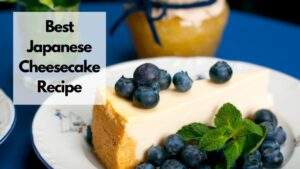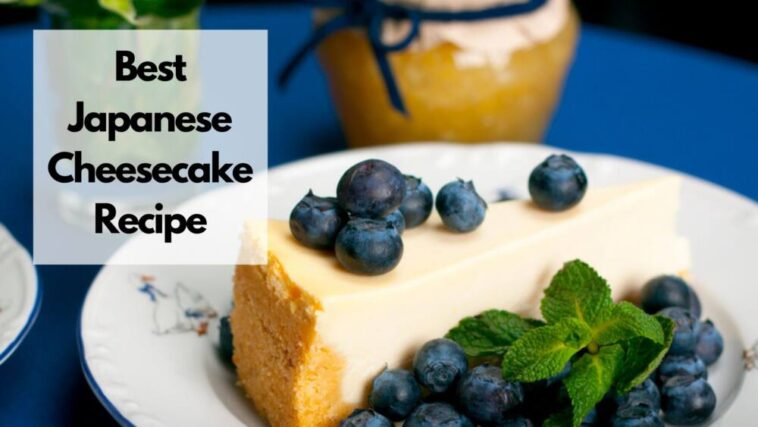Here’s a simple and easy 3 ingredients Japanese cheesecake recipe for you to try!
Imagine sinking your fork into a slice of cheesecake that’s not just delicious but also defies gravity with its cloud-like fluffiness.
That’s the magic of Japanese cheesecake, a delightful treat that combines simplicity with decadence.
Having grown up in Japan and developed a passion for Japanese cuisine, I’ve tried my hand at various recipes, but none have been as consistently impressive as this 3-ingredient Japanese cheesecake.

Today, I’m excited to share my experience and guide you through the process of creating this heavenly dessert.
Key Takeaways
- The 3 ingredient Japanese cheesecake recipe is a simple and easy-to-make dessert that is perfect for beginner bakers.
- The essential ingredients for this recipe are cream cheese, eggs, and white chocolate, which create a unique and delicate flavor.
- This classic cheesecake is known for its light and fluffy texture, and requires minimal equipment to make.
- Related: Easy Matcha Macarons Recipe
Page Contents
3 Ingredients Of Japanese Cheesecake Recipe
Eggs
The backbone of this ethereal dessert is undoubtedly the eggs. Their unique ability to create structure and lift is what gives Japanese cheesecake its signature jiggle.
The yolks contribute richness and flavor, while the whites, whipped to stiff peaks, introduce the airy, melt-in-your-mouth texture.
It’s fascinating how such a simple ingredient can play such a crucial role in the alchemy of baking.
Cream Cheese
Cream cheese forms the creamy canvas upon which the entire flavor profile of the cheesecake is built.
Its luscious texture and subtle tanginess provide a perfect contrast to the sweetness of the other ingredients.
Choosing a high-quality cream cheese is essential for achieving that decadent taste that sets Japanese cheesecake apart from its Western counterparts.
As someone who takes pride in crafting authentic Japanese dishes, I’ve found that using Japanese cream cheese adds an extra layer of authenticity to the recipe.
White Chocolate
The secret to the delightful sweetness and velvety smoothness of Japanese cheesecake lies in the addition of white chocolate.
Not only does it complement the cream cheese beautifully, but it also melts seamlessly into the batter, creating a luxurious consistency.
Choosing good-quality white chocolate is crucial to achieving the perfect balance of sweetness without overpowering the delicate flavors of the cheesecake.
- Related: Krispy Kreme In Japan Menu
Simple Steps to Cheesecake Heaven
Now, let’s dive into the step-by-step process of creating this delectable dessert:
Step 1: Preheat the Oven and Prepare the Pan
Begin by preheating your oven and preparing a springform pan with parchment paper. This ensures easy removal and a flawless presentation.
Step 2: Melt the Chocolate and Cream Cheese
Gently melt the white chocolate and cream cheese together, creating a velvety mixture. This forms the rich base of the cheesecake.
Step 3: Separate the Eggs and Whip the Whites
Carefully separate the egg yolks from the whites. Whip the whites into stiff peaks – a crucial step for achieving the characteristic fluffiness of Japanese cheesecake.
Step 4: Gently Fold the Whites into the Mixture
Combine the whipped egg whites with the chocolate and cream cheese mixture. The key here is to fold gently, preserving the air in the batter for that airy texture.
Step 5: Bake Using the Water Bath Technique
Place the pan in a larger pan filled with water, creating a water bath. This technique prevents the cheesecake from drying out, resulting in a moist and tender interior.
Step 6: Let the Cheesecake Cool Slowly
After baking, allow the cheesecake to cool gradually. This gradual cooling process prevents cracking and ensures a smooth, flawless appearance.
Step 7: Enjoy!
Once cooled, your Japanese cheesecake is ready to be enjoyed. Cut into a slice and marvel at the cloud-like texture you’ve created.
Tips and Tricks for Cheesecake Perfection
To guarantee success, keep these tips in mind:
Room Temperature Ingredients
- Ensure that your cream cheese, eggs, and white chocolate are at room temperature before starting. This ensures smooth mixing and a uniform batter.
Gentle Folding
- When combining the whipped egg whites with the chocolate and cream cheese mixture, fold gently. This preserves the air in the batter, contributing to the desired lightness.
Avoid Overbaking
- Japanese cheesecake is meant to have a slight wobble in the center when done. Overbaking can result in a dry texture, so trust the process and embrace the jiggle.
Patience is Key
- Allow the cheesecake to cool completely before slicing. This patience ensures clean cuts and a visually appealing presentation.
Beyond the Basics Of Japanese Cheesecake
Now that you’ve mastered the basic recipe, feel free to get creative:
Flavor Variations
- Add a teaspoon of vanilla extract for a classic touch, or experiment with matcha powder for a subtle green tea flavor.
Toppings
- While the simplicity of the cheesecake is divine on its own, consider topping it with fresh berries, a drizzle of fruit coulis, or a dusting of cocoa powder for an extra layer of flavor and visual appeal.
Baking Times
- Play around with baking times to achieve your desired texture. A shorter bake results in a denser cake, while a longer bake produces a lighter, airier result.
Conclusion
In conclusion, this 3-ingredient Japanese cheesecake has become a staple in my kitchen, impressing friends and family alike.
The combination of eggs, cream cheese, and white chocolate may seem too simple, but the result is nothing short of magical.
I encourage you to try this recipe for yourself and experience the joy of creating a dessert that’s as delightful to make as it is to eat. So, roll up your sleeves, preheat that oven, and get ready to savor a slice of cheesecake heaven.
Bonus
As promised, here’s a tempting photo of the finished cheesecake, showcasing its jiggly perfection. Additionally, find a recipe card below for easy reference:
Japanese Cheesecake Recipe Card
Ingredients:
- 200g cream cheese (preferably Japanese cream cheese)
- 200g white chocolate
- 6 large eggs, separated
Instructions:
- Preheat the oven to 325°F (160°C) and line a springform pan with parchment paper.
- Melt the cream cheese and white chocolate together until smooth.
- Whip the egg whites to stiff peaks.
- Gently fold the egg whites into the chocolate and cream cheese mixture.
- Pour the batter into the prepared pan and place it in a larger pan filled with water to create a water bath.
- Bake for approximately 25-30 minutes or until the top is golden brown and the center has a slight wobble.
- Allow the cheesecake to cool in the oven with the door ajar for about an hour.
- Chill in the refrigerator for at least 4 hours before slicing and serving.
Also Read:
Best Japanese Cheesecake Recipe

Check out the best Japanese cheesecake for you to try!
Type: Dessert
Cuisine: Japanese
Keywords: cheesecake, Japanese cheesecake
Recipe Yield: 12 servings
Preparation Time: 25 minutes
Cooking Time: 30 minutes
Total Time: 55 minutes
Recipe Ingredients:
Recipe Instructions: Ingredients: 200g cream cheese (preferably Japanese cream cheese) 200g white chocolate 6 large eggs, separated Instructions: Preheat the oven to 325°F (160°C) and line a springform pan with parchment paper. Melt the cream cheese and white chocolate together until smooth. Whip the egg whites to stiff peaks. Gently fold the egg whites into the chocolate and cream cheese mixture. Pour the batter into the prepared pan and place it in a larger pan filled with water to create a water bath. Bake for approximately 25-30 minutes or until the top is golden brown and the center has a slight wobble. Allow the cheesecake to cool in the oven with the door ajar for about an hour. Chill in the refrigerator for at least 4 hours before slicing and serving.
5





